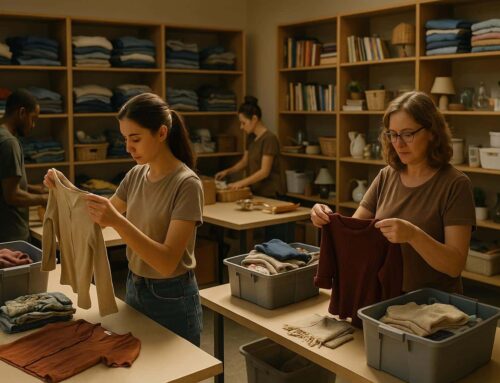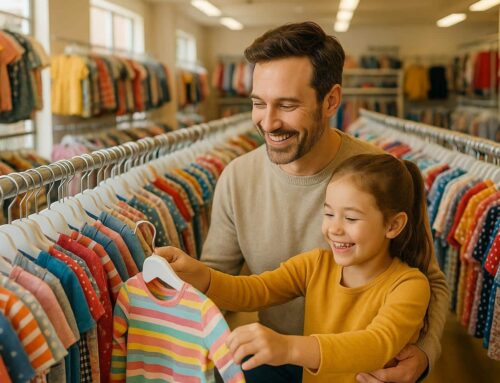Upcycling connects people while reducing waste. It’s more than reusing items – it’s about teamwork, skill-sharing, and creating sustainable solutions. Here’s how upcycling strengthens communities:
- Workshops and Events: Neighbors collaborate to repair furniture, sew, or create art, building relationships and sharing skills.
- Local Partnerships: Nonprofits and businesses like City Thrift provide resources, space, and materials to support upcycling projects.
- Environmental Impact: Upcycling reduces landfill waste, saves energy, and lowers carbon emissions.
- Economic Benefits: It creates jobs, supports small businesses, and encourages sustainable entrepreneurship.
From DIY projects to community programs, upcycling fosters collaboration and drives change. Whether donating items, attending events, or starting small at home, everyone can contribute to this growing movement.
Ways Upcycling Builds Community Connections
Upcycling has a unique way of bringing people together, fostering connections across different age groups and backgrounds. By focusing on shared goals like creativity and environmental awareness, these projects help break down barriers and build lasting relationships.
Community Workshops and Group Events
Workshops and group events are at the heart of community upcycling efforts. These gatherings transform ordinary spaces into creative hubs where neighbors can share knowledge and work on meaningful projects. For instance, furniture repair sessions often attract people with varying skill levels, creating opportunities for mentorship and collaboration.
During the COVID-19 pandemic, communities came together to repurpose materials for sewing reusable cloth masks. They shared designs, techniques, and even found creative solutions like using repurposed materials for straps when elastic supplies ran low. This collective effort not only addressed a critical need but also likely helped reduce illness and save lives.
Events like clothing swaps and craft fairs also serve as regular meeting points for community members. These gatherings often start small but grow as participants discover their practical and social benefits. For example, parents might bring their kids to learn basic sewing skills, while teenagers contribute fresh, modern design ideas. The exchange of techniques and ideas during these sessions builds confidence and inspires participants to take on larger, more ambitious projects.
This hands-on, collaborative spirit often spills over into other areas, encouraging neighbors to share skills and tackle diverse projects together.
Sharing Skills and Ideas Through Projects
Upcycling empowers communities by turning everyone into both a teacher and a learner. A retired carpenter might teach furniture restoration techniques, while a college student introduces modern design software to help plan projects. This exchange of knowledge creates a dynamic learning environment where everyone contributes.
Some informal sessions go beyond upcycling to teach broader sustainability skills, such as composting or energy conservation. What might begin as a simple workshop can evolve into regular meetups where participants collaborate on increasingly complex projects.
Community gardens also play a key role in upcycling education. Discarded pallets can become raised beds, old containers can be repurposed as planters, and salvaged materials can be turned into storage solutions. These hands-on activities not only promote sustainable practices but also strengthen community ties as neighbors work together on shared goals [16, 2].
These grassroots collaborations often pave the way for partnerships with local businesses and nonprofits.
Working with Local Businesses and Nonprofits
Local businesses and nonprofits can help take community upcycling efforts to the next level by offering resources, space, and expertise that smaller groups may lack. These partnerships can turn initial enthusiasm into long-term, impactful initiatives.
For example, City Thrift supports local upcycling projects by accepting donations, providing affordable materials, and connecting volunteers with shared interests in sustainability and community service.
In Charleston, South Carolina, Maia Moms launched a crowdfunding campaign to create the “Creative Flow Reuse Center“, a project that highlights the power of collaboration. The center diverts materials from landfills, supports local artists, hosts workshops, and sells recycled creations to fund the nonprofit. With backing from the Charleston County recycling department and volunteer support from the North Charleston Artist Guild, this initiative showcases how partnerships can amplify community impact.
“We will be engaged in the business of collecting industrial and residential discards for creative reuse. The efforts of this Center will promote recycling, provide revenue for local artists and generate funds for the nonprofit.” – Maia Moms
Ultimately, successful partnerships grow from shared values around sustainability and community building. By starting small – through co-hosted events, shared content, or joint initiatives – organizations can build trust and gradually develop larger, more impactful collaborations.
Environmental and Economic Benefits of Upcycling
The environmental and economic gains from upcycling connect directly to community-driven projects. By turning discarded materials into valuable items, upcycling helps tackle pressing environmental and economic concerns while strengthening local communities.
Keeping Items Out of Landfills
The environmental impact of upcycling becomes strikingly clear when you look at the numbers. On average, Americans generate 4.9 pounds of waste per person every day. In 2018 alone, the U.S. produced 292 million tons of municipal solid waste, with half of it ending up in landfills. In Kansas City, for example, regional landfills are already over half full and are expected to reach capacity by 2037.
Local initiatives are stepping up to address this issue. ScrapsKC, a Kansas City-based organization, diverted an impressive 1 million pounds (500 tons) of materials from landfills in June 2024 through resale, donations, and reallocation.
“What we try to do is to provide resources and education and a space for people to upcycle materials, but the most important piece is to change people’s minds to become more responsible consumers.” – Brenda Mott, Executive Director of ScrapsKC
Upcycling also targets specific types of waste. For instance, Théla repurposes single-use plastic bags into colorful, hand-crocheted products. Each bag is carefully cleaned and sorted by color before being transformed into something new.
“Upcycling prevents materials from going to landfills, it saves valuable landfill space while also reducing the risk of toxic gases and other pollutants entering the atmosphere or poisoning the soil.” – O. Berk
These environmental efforts don’t just protect the planet – they also open doors to economic growth.
Supporting Local Economy Through Repurposed Items
Beyond its environmental benefits, upcycling has a meaningful impact on local economies. It encourages entrepreneurship and supports small businesses. The global upcycling market is expected to reach $56.8 billion by 2027, and according to a Nielsen study, 66% of global consumers are willing to pay more for sustainable products. This growing demand creates opportunities for innovative, eco-conscious goods.
Organizations like City Thrift contribute significantly to this ecosystem. By accepting donations and selling affordable second-hand items, City Thrift supports upcycling while using proceeds to fund City Union Mission’s homelessness and poverty relief programs.
The textile industry is another area where upcycling shows promise. The Environmental Protection Agency reported that over 35 million tons of textiles were produced in 2018, but only 15% were recycled or upcycled. Meanwhile, the global textile recycling market was valued at $6.9 billion in 2022 and is projected to grow to $9.4 billion by 2027.
“Our goal is always to reduce what we are consuming.” – Keli Campbell, Founding Board Member of Magpie Creative Reuse Collective
Upcycling doesn’t just reduce waste – it creates jobs in areas like craftsmanship, design, and logistics. By empowering communities to repair, repurpose, and create locally, upcycling fosters economic self-reliance, reduces dependence on global supply chains, and builds resilience against external disruptions.
How to Join Upcycling Efforts in Your Area
Getting involved in local upcycling efforts doesn’t require special skills or big commitments. Whether you’re donating items, attending workshops, or tackling simple projects at home, there are plenty of ways to contribute to this movement while strengthening your community connections.
Donating Items for Community Projects
Donating items is a straightforward way to support upcycling initiatives. Many local centers, like City Thrift, provide online lists of accepted items. It’s a good idea to check these guidelines and organize your donations accordingly.
Sort your items into categories – such as clothing, art supplies, or household goods – and make sure they’re clean and free from odors, stains, or pet hair. This extra step makes it easier for centers to process and repurpose your donations. Some organizations, like The Wardrobe on the East Coast, even accept items in less-than-perfect condition. Partnering with Helpsy, The Wardrobe recycles items with stains, tears, or missing buttons, ensuring nothing goes to waste.
“We often hear that donors bring us their ‘good’ stuff and take their ‘not-so-good’ stuff elsewhere. We are now a one-stop donation center. This means more convenience for you with a guarantee that your donations (no matter the quality) will directly support our mission, either as new outfits for our guests or as financial support for our mission. Let’s extend the life-cycle of all your clothes!” – Sheri Cole, Executive Director of The Wardrobe
Once your donations are ready, consider exploring local upcycling events to further connect with others in your community.
Finding and Joining Local Upcycling Events
Local upcycling events are great opportunities to learn, share, and engage with like-minded people. Creative reuse centers often serve as hubs for workshops and activities. To find these events, check nonprofit websites, community calendars, or your local reuse center.
If you’re not sure where to start, try searching online using terms like “creative reuse center” along with your city’s name. You can also reach out to community centers or nonprofits directly – many of them host upcycling programs that aren’t always widely advertised. Don’t forget to check bulletin boards at libraries or community spaces, as well as local government websites, for announcements.
For example, UpCycle Creative Reuse Center in Alexandria, Virginia, offers summer camps, children’s programs, and weekly open houses with family-friendly activities. Events like these show how upcycling can bring together people of all ages and create lasting connections.
If you can’t find upcycling events nearby, why not suggest starting one? Community centers and libraries are often open to new initiatives that address environmental issues while bringing people together.
Prefer to start small? Try some simple DIY projects at home.
Beginning with Simple DIY Projects at Home
Upcycling at home is a fun way to ease into the movement while honing your skills. These projects are perfect for beginners and can help you gain confidence before diving into larger community efforts.
Furniture makeovers are a great place to start. Give an old cabinet a fresh look with peel-and-stick wallpaper, revive worn-out furniture with chalk paint, or turn an old ladder into stylish shelving.
Textile and container projects are also beginner-friendly. Repurpose old t-shirts into reusable bags or braided coasters, transform glass jars into storage containers, or use tin cans to create hanging planters.
Decorative crafts let you combine creativity with sustainability. Wrap plain glass vases with jute rope, make candles in vintage teacups, or turn wine corks into coasters.
“One of the best ways to reduce your environmental footprint is by not buying new items: the more sustainable choice would be to upcycle.” – Emma Seymour, Good Housekeeping Institute’s senior textiles analyst
The key is to start small. Begin with simple projects that require basic tools and gradually work your way up to more advanced techniques. Take photos of your progress to share with others – it’s a great way to inspire friends and neighbors to join the upcycling movement.
These DIY efforts not only help you build your skills but also show how individual actions can contribute to larger environmental and social goals. As you grow more confident, you’ll be ready to collaborate on bigger community initiatives and share your ideas with others.
Tracking the Results of Community Upcycling Programs
Understanding the impact of upcycling programs is essential for improving their effectiveness and gaining support. By examining environmental benefits, community participation, and economic outcomes, organizations can showcase their value and encourage broader involvement.
Measuring Environmental Impact
Tracking environmental outcomes reveals how upcycling reduces waste and conserves resources. Key metrics include waste diversion rates, energy savings, and carbon emission reductions.
One method is conducting waste audits to measure how much material is diverted from landfills. For instance, Earth5R‘s programs diverted over 300 tons of waste and prevented approximately 500 metric tons of CO₂ equivalent emissions.
Energy savings also highlight the benefits of upcycling. Repurposing aluminum cans into art installations, for example, uses up to 95% less energy than creating aluminum from raw materials. Similarly, extending the life of clothing by just nine months can cut carbon, water, and waste footprints by 20–30%.
Carbon emission reductions are another key indicator. Upcycling can reduce emissions by as much as 70% compared to producing new items. For example, reusing just 2.2 pounds of clothing can save about 55 pounds of CO₂ emissions.
Here’s a quick look at how different sectors benefit:
| Sector | Waste Type | Key Metric | Potential Impact |
|---|---|---|---|
| Textile | Fabric scraps, clothing | Waste diversion rate | Up to 95% diversion with upcycling and recycling combined |
| Furniture | Old furniture, wood waste | Landfill reduction | Significant drop in furniture waste |
| Plastic | Bottles, packaging | Upcycling rate | Helps reduce single-use and ocean plastics |
Programs can track these metrics monthly or quarterly to spot trends. Smaller initiatives may start with spreadsheets, while larger ones might use specialized software for better data management.
Once environmental progress is clear, the next step is measuring how these efforts engage the community.
Monitoring Community Participation
Community involvement is a vital part of any upcycling program. Participation can be measured through workshop attendance, volunteer hours, donation volumes, and repeat engagement.
For example, Earth5R’s Powai Zero-Waste Initiative engaged over 5,000 households, 20 schools, and 50 businesses, achieving a 60% waste segregation rate at the source within just six months. Organizations like City Thrift can also track donation patterns, volunteer contributions, and event attendance to gauge involvement.
“Measuring success in community participation is about understanding if the process truly empowered the community and led to more meaningful and sustainable outcomes.” – Sustainability Directory
Qualitative feedback is equally important. Surveys, focus groups, and personal stories can provide deeper insights into how upcycling has impacted individuals and communities. These stories not only help refine programs but also serve as powerful tools for outreach and awareness campaigns.
Beyond community engagement, upcycling programs can deliver measurable economic benefits.
Calculating Economic Impact
Economic benefits from upcycling often include job creation, cost savings, and revenue generation.
Upcycling and recycling efforts are known to create far more jobs than traditional waste disposal. For example, recycling generates nine times more jobs than landfilling, while reuse can create up to 30 times more jobs. In 2020, the recycling and reuse industry supported 681,000 jobs, paid $37.8 billion in wages, and contributed $5.5 billion in tax revenues.
Real-world examples highlight these impacts. Blue Star Recyclers, operating in Colorado and Illinois, created over 40 local jobs, generated $4 million in local revenue, and saved taxpayers $1.5 million through electronics recycling. Similarly, the Rebuilding Exchange in Chicago diverted over 9,400 tons of building materials from landfills while training more than 80 people for circular economy jobs.
Cost savings are another advantage. Florence, Alabama’s recycling program, for instance, avoided over $1 million in landfill fees from 2009 to 2019 while generating additional revenue from material sales. Tracking these savings and any income from selling upcycled items provides a clear picture of the economic impact.
Revenue generation from upcycled products also creates new income streams. Earth5R’s training programs illustrate this well: in Mumbai, 70% of women trained in fabric upcycling reported stable income, while participants in Nairobi earned between $200 and $300 per month, well above the local minimum wage.
These numbers demonstrate that upcycling doesn’t just repurpose materials – it strengthens communities and boosts local economies.
Working Together for a Better Future
Upcycling isn’t just about giving discarded materials a second chance – it’s about transforming communities too. Through activities like collaborative workshops, skill-sharing events, and local partnerships, upcycling helps build stronger, more connected neighborhoods. As Indrė from Platformgifted.eu explains:
“Upcycling often requires teamwork and collective effort, fostering a sense of solidarity among community members. Collaborative projects bring people together, enhancing social cohesion and promoting a shared vision for a sustainable future”.
But the impact of upcycling goes far beyond environmental benefits. When people join forces on these projects, they create social networks that can help tackle a range of challenges. Take the U-Café project in Newcastle-upon-Tyne, for instance. This initiative brought together communities and academics to construct an entire café out of recycled materials. In doing so, they not only explored the relationship between people and materials but also uncovered barriers to making upcycling more widespread. Projects like these highlight how upcycling can unify and inspire communities.
Organizations like City Thrift are key players in this movement, bridging the gap between upcycling and community support. By running non-profit thrift stores, they fund crucial programs in areas like education and housing. As City Thrift puts it:
“Donating to thrift stores might seem like a small act, but it has a huge impact”.
Getting involved can be as simple as donating items, volunteering at a local center, or organizing a donation drive in your workplace or neighborhood.
For those eager to take it a step further, joining local upcycling initiatives is a great way to make a difference. These efforts, whether led by grassroots groups or large organizations, show how upcycling can breathe new life into everything from outdated technology to everyday items, improving lives in the process.
The beauty of upcycling lies in its simplicity and accessibility. Refinishing furniture for nonprofits, organizing recycling events, or even sharing easy upcycling tips online – all these actions contribute to a larger movement. As City Thrift reminds us:
“Giving back can be easy and even fun when you connect with organizations like City Thrift”.
FAQs
How can I start upcycling at home to help reduce waste and bring people together?
Starting an upcycling project at home can be a rewarding way to cut down on waste while connecting with your community. Start by taking a fresh look at items around your house that you no longer use – things like old clothes, furniture, or random household items. Think outside the box about how these could be given a second life. For example, you could transform old T-shirts into reusable shopping bags or turn wooden pallets into one-of-a-kind furniture.
Pick a project that feels doable for your skill level, and make sure you have the right tools and materials on hand, such as paint, glue, or sewing supplies. Once you’ve finished, share your creations with friends, family, or neighbors. It’s a great way to start conversations, inspire others, and build a stronger sense of community. Upcycling doesn’t just help the planet – it brings people together. And if you need extra materials, consider donating to or shopping at local thrift stores like City Thrift. It’s a simple way to support local causes while making your project even more impactful.
How do local businesses and nonprofits support upcycling in the community?
Local businesses and nonprofits play an important role in promoting upcycling within communities. They organize workshops to teach upcycling skills, host donation drives for reusable materials, and spread awareness about sustainable practices. These activities not only cut down on waste but also bring people together, sparking collaboration and creativity.
Nonprofits often serve as a link between individuals and resources, offering opportunities for residents to volunteer or donate items for upcycling projects. Meanwhile, local businesses can take donated materials and turn them into new products, supporting both environmental goals and the local economy. By working together, these groups help create stronger, more connected communities while paving the way for a greener future.
How Upcycling Builds Stronger Communities
How does upcycling benefit local communities, environmentally and economically?
Upcycling brings a host of benefits to both the environment and local economies. By transforming materials destined for landfills into something useful, upcycling helps cut down on waste, reduces pollution, and conserves natural resources. For instance, studies suggest that upcycling could reduce landfill waste by up to 30%, offering a tangible way to lessen our environmental footprint.
From an economic perspective, upcycling opens doors for local businesses and entrepreneurs. Small workshops, craft markets, and similar enterprises thrive on upcycling, creating jobs and stimulating local economies. These efforts do more than just generate income – they foster a sense of collaboration and shared purpose, encouraging people to come together and build a stronger, more connected community.
Organizations like City Thrift are at the forefront of this movement. By accepting donations of used goods and reselling them at affordable prices, they not only help reduce waste but also contribute to causes like homelessness and poverty relief. These initiatives highlight how upcycling can drive positive change while strengthening the bonds within a community.






